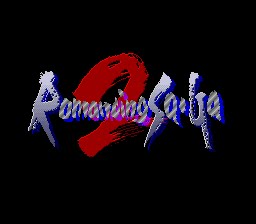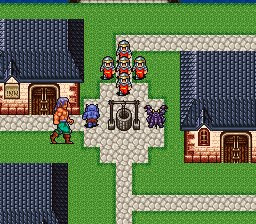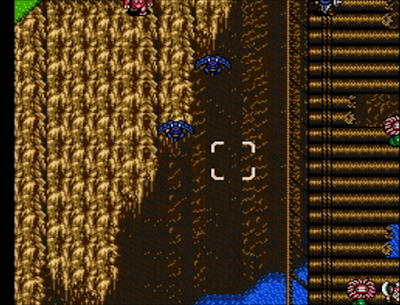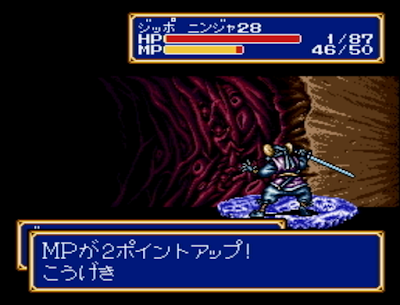As I mentioned when I posted Super Robot Taisen 2, I played a large number of the SRT games over the last decade or so. The entries for these games will be reposts of the comments I made while playing the games, so they will have a different tone from the normal posts.
SRW 3 is notable in the history of SRPGs for being one of the first to have a branching storyline with very different endings (different final bosses even).
—
SRW 3 was the first of several SRW games for the Super Nintendo. From what I’ve seen on Japanese sites, this game is fondly remembered by long-time players, and considered one of the best of the games. People liked the difficulty, as well as the numerous branching story paths that can actually affect the storyline (i.e. appeasing Mekibos , getting Gato on your side, or making Scirocco the final villian instead of Wendolo). It’s also known fairly well among English-speaking players because of the full translation patch that was made for it (still the only SRW other than the odd-man-out SRW 1 to get a full translation patch).
All of the series from SRW 2 return, and five new series debut. Gundam 0080 and 0083 round out the standard UC Gundams (08th MS team did not yet exist, and V Gundam was still in progress when the game came out, and probably wasn’t even begun yet when development on SRW 3 started.) On the Super Robot side, Combattler V, Raideen, and Daitarn 3 all debut.
However, even within the series that already existed in SRW 2, a lot more material gets put in. There are over 60 possible playable characters in this game, as opposed to around 20 in SRW 2. There are also more named characters on the enemy side from each series.
As far as the system goes, SRW 3 takes a humongous step forward towards the “modern” SRW gameplay. These are some of the changes that were made from SRW 2’s system:
– Pilots and robots now have separate stats, and you can switch pilots on certain robots.
– The scale of the numbers is still low, but moves a long way towards how they are in recent games.
– Each robot could only have 2 attacks in NES (2 per transformation) but the number of attacks is now effectively unlimited; even the crap suits like the GMs have 4 attacks, and Combattler V has several pages.
– The item shop was removed (so there are no items at all in 3)
– Will, bullets, and energy have all been added to the game
– You can now indirectly affect the action of your units when they are attacked, by picking an overall strategy from a list
– Terrain compatibilities of units were added
– You can upgrade your mechs during the intermission
– You can sell old mechs
– The seishins are much more like the modern ones, although the list is much smaller than it later became
– You now have more characters than can be sortied each level, and you have to choose who you will send out (and the optional characters no longer leave soon after they join).
Things that are still lacking:
– You cannot upgrade weapons
– There are no items in the game
– You cannot pick evade/block/counter on a per-attack basis
– Repairing still does not grant EXP
– The skills (i.e. newtype, shield block) still do not exist
– The concept of a “post-move attack” still does not really exist; any range-1 (and only a range-1) attack can be used post-move.
I played the PSX version remake of this game, which is considerably easier, but I haven’t played the SNES version yet. Should be a barrel of laughs.
Stage 1 – Dark Clouds
The prologue brings in the Zabi Family resurrecting DC; the writers seem to be moving more towards using the anime plots, although they still aren’t really doing that. They also had to explain why the heroes go back to their crap units after 2, the reason is that the Earth Federation distrusts them. Char also appears again, and his role is a little unusual — in the anime series he never betrayed the Zabi family to the benefit of the allies (i.e. he only did it for his own purposes). The G3 gas incident is coming in from Zeta Gundam. This is also notable for being the only appearance of the Proto Getter in the series.
Stage 2 – Knight of the Rose
I took the side route, so you just have to fight a small force headed by Mashmyre — nothing much to say about this.
Stage 3 – G-3
This is a rough stage. The Dogos Gear runs away, but it’s kind of tough to deal with Lila, Kakricon, and Jerid with your weak units. I used Getter a lot because he has the Luck seishin…very happy to get the real Getter after this stage.
The plot is also developing; these “mysterious aliens” (bian’s prediction) are attacking Earth. Now you also get Reccoa after this mission which is a contradiction to SRW 2; there’s no indication that anyone in Londo Bell remembers that she was an enemy in SRW 2.
Stage 4 – Entering the Atmosphere
First encounter with the Inspector troops. On the one hand I feel like they kind of copped-out; they just used the same old Gundam and Mazinger/Getter enemies but with robot/faceless pilots instead. But, it is kind of interesting to see this mysterious force using Earth robots. Kamille also joins in this stage — the same Gundam theme is used for all Gundam units no matter what series they are from.
Something else that was added in this game is the ability for people to have conversations before they fight. So when you attack Jerid with Kamille, they have a conversation — but in another instance of ignoring any continuity from SRW 2, they both act like they have never met before. You can get Emma on your side here, unfortunately she has swapped out her Marasai for the Mk-II.
At the end of the stage Gihren Zabi gives a First Gundam-like speech about unifying Earth and space under the Zabi Family and DC, following the will of Bian Zoldark (instead of Degwin Zabi as in FG anime).
Stage 5 – Gundam Theft
0083 enters the SRW world, and they basically just copy the content of episodes 1 and 2. Kou sucks as usual, but without Amuro and Kamille having the newtype abilities, he’s not quite as bad.
Stage 6 – Gato’s Raid
Not much going on here. After this you get Christina McKenzie; there’s not much in the way of 0080 inclusion here, just Chris and Bernie.
Stage 7 – Seaside Panic
The part at the beginning where they go to the beach is an early example of a conversation that isn’t just “why are we fighting the next set of enemies”; the amount of these increases vastly as the series progresses.
Stage 8 – Combattler V
This is a notable, but odd stage. This is the first time in SRW that some anime plot comes in completely separate from the Divine Crusaders storyline. On the other hand, it’s odd because Garuda just shows up and gets killed in this mission. I’m not sure why the designers did this; maybe they didn’t quite realize that they could keep multiple plots going in one game, but then why did they include this little bit at all? Did they feel like some explanation was needed for why Combattler V would join Londo Bell?
Stage 9 – Crimson Wings
Ashura and Brocken make their first appearance in the SRW world. My units are starting to get a little overpowered by the enemies, but the next two stages have powerful units for me.
Stage 10 – Hero Raideen
Like the Combattler stage, this pits you against the Raideen enemies which you finish off quickly, then the alien units come.
After this stage, Four gets captured — they kept continuity by having her on your side, but then they wanted to have the Kamille vs. Four battle again so they set this up. Sort of cheap, but oh well.
Stage 11 – The Rumored Haran Banjo
Unlike the Raideen and Combattler intros, there are no Daitarn enemies in this stage, just the robot. There’s a pretty big enemy force here although you can get some relief if you set up your guys right since the Inspector units will fight the DC units.
Stage 12 – To Space
Quattro Bajina makes his first appearance in SRW. Sayla doesn’t get much chance to talk to him since she leaves after this mission, but the conversation with Bright from First Gundam does appear.
Steiner is from 0080; I didn’t remember any enemies from 0080 besides Bernie. You can do the scene with Christina and Bernie fighting; Bernie sucks so there’s not really much point unless you want to get all the secrets.
Stage 13 – In the Midst of Sorrow
Oops, I forgot to sortie Chris, so no Bernie. Huge loss. This was a much easier level after the previous two, and you get a battleship to destroy for 40,000 coins (with Luck). Towakun and Demitri are kind of random in weak suits; I have no idea who they are.
The missions in this game tend to get a little repetitive because it’s just the same DC or Alien units every battle, and they all rush you.
Stage 14 – Suspicion
There’s a huge enemy force in this mission but they’re pretty weak enemies so it’s not too bad. I love the Dogos Gear — another 40,000 coins.
The “suspicion” in the title refers to DC possibly having some relationship to the aliens.
Stage 15 – Pursuit Battle
You get Roux and Judau here (of course the ZZ is a lot more useful than she is). The ZZ means yet another ALL (MAP) attack. The Hyaku Shiki’s MAP attack isn’t a straight line like later games, it’s a rectangle like everyone else.
Stage 16 – Fight at Side 1
Yay, another Dogos Gear stage. 🙂
Gato turns against DC here, although there are different factions — Gato works for Gihren Zabi while Bask is in Kycilia’s group. Seems Bask is consorting with the aliens, though.
Stage 17 – Shangri-la
This is a really short stage, but kind of odd — Mashymre and Gotton help you out. F91 also joins up here; finally I’m getting a full team of good units.
Stage 18 – Conscon’s Assault
Poor Conscon. They only ever put him in SRW or Gundam games for one reason, [2019 me: To make fun of his surprise that you can beat his Rick Doms.]
This stage is fairly easy; I beat it in 5 turns so I didn’t have to face Lakan and the reinforcements. The Nu Gundam is a welcome sight after this stage; I’m a little surprised they give it to you so early in the game. Funnel units are really important in all the early SRW games, especially when the Newtype ability comes into the game (in 4?).
The other funnel users I can get are Puru’s Quebeley (stage 29), Sazabi (stage 30), and Puru II’s Jagd Doga (stage 32). I’m not going the Kyara route, I don’t think.
Stage 19 – Nightmare of Solomon
This is a neat stage. First of all, Masaki shows up in his Cybuster, and the Inspectors make their first appearance. The only one that sticks around is Vigaj.
Gato also comes in and blows away 13 of the units, which is quite helpful, and is a neat story element. I still think the designers were much more adventerous with their story elements in these early games. They really nerfed this part in the Complete Box version; Gato only destroys *3* units. After that, the most difficult part is the force around Bask. Rosamia in particular has double move, is on good terrain, and the Baund Doc has high armor. She took multiple finishing moves from SR’s to take down.
Vigaj leaves if you have Gato come in, but what if you don’t activate that event?
Oh yeah, Dogos Gear. 😀
Stage 20 – Prelude to a Hard Battle
This is an “inside the base” mission, which they seemed to use a lot in the early games but not so much later on. Vigaj is here and you actually have to fight him this time, but as long as you can reduce his HP to 80% in one round it’s not so bad (I used God Bird, Breast Fire, and Sun Attack and that did it).
Kamille now has double move; I want to get more people to have it before I reach the Ryuune stage.
Stage 21 – Terror! Big Zam
Haman makes her first appearance (in SRW 3) here, in the Dogos Gear. This makes the Dogos Gear very hard to hit, and sadly you can’t kill it — maybe if you could do 6500 in one shot. But if you do any damage to it, she runs away and Big Zam comes out.
Sleggar will take out the Big Zam for you like in FG, but it’s harder than Complete Box. In Complete Box, as soon as the Big Zam appears, Sleggar goes over and kills it. Here, Sleggar has to actually reach the Big Zam without getting killed. This makes it a bit harder.
Also in this stage is the very frequently used device of “Persuade Four with Kamille, then destroy the Psycho Gundam to get her on your team”.
Cyflash is unbalanced as usual.
Stage 22 – Ryuune, and Valsione
This stage was reused, almost line-for-line (even down to her use of Psycho Flasher), in OG1, although the F91 bunch is replaced with OG-only DC enemies.
Ryuune is the new Banpresto Original hero(ine) for this game; they gave her the same music as Masaki (neppu! shippu! cybuster); I’m not exactly sure why, but maybe it was just so the designers wouldn’t have to make another music track. In Complete Box she is a godly character because she has the supremely unbalanced Taunt seishin; even here she seems good with her 5-use 1800 power Cross Masher (which I assume is not a beam attack) and ALL attack that works like Cyflash.
(Some people apparently have trouble keeping Ryuune alive; the key both here and in the CB version is to leave an enemy at low HP for her to attack and kill each turn. Do not leave the Laflacia as the only enemy unless you are sure you can kill it before the enemy turn.)
The Laflacia is even better than the Dogos Gear; 60000 gold with Luck.
Ryuune’s first appearance, with her oddly proportioned mech about which absolutely nothing is said in the game:




























































